Unit - 3
Genetics
Q1) Explain Mendel’s laws of Segregation?
A1) The first of Mendel’s laws (law of Segregation) states that genes are transferred as separate and distinct units called as gene that are carried from one generation to the next. The two members (alleles) of a gene pair, one gene on each of paired chromosomes, separate during the formation of sex cells from a parent organism. One-half of the sex cells will have one form of the gene, one-half of the sex cells are obtained from the other form; the offspring that result from these sex cells will reflect those proportions.
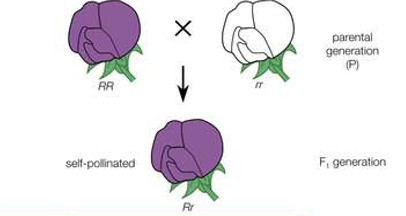
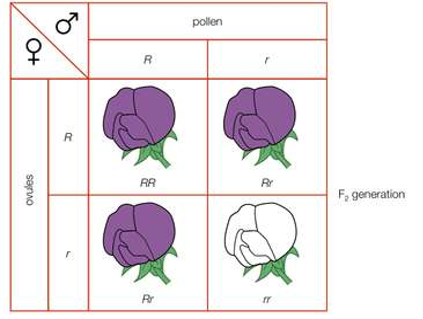
Fig: Mendel's law of segregation Cross of a purple-flowered and a white-flowered strain of peas. R stands for the gene for purple flowers and r for the gene for white flowers.
Q2) Define Allele with an example?
A2) William Bateson, first coined the term ‘allelomorph’ (alternative form), meaning one of an array of different forms of a gene. Later, this term was shortened by others to ‘allele’. So, allele is defined as one of two or more alternative forms that are present in a single gene. Alleles for any given gene occupy the same locus or position on homologous chromosomes.
Each of the different alleles of a single gene have a unique nucleotide sequence, and their activities are all concerned with the same biochemical and developmental process, although their individual phenotypes may be different. For example, tall and dwarf are alleles determining the height of the pea plant.
Alleles may occur in pairs, or there may be multiple alleles affecting the expression (phenotype) of a particular trait. The combination of alleles that an organism carries constitutes of its genotype. If the paired alleles are the same, the organism’s genotype is said to be homozygous for that particular trait; if they are different, the organism’s genotype is heterozygous. A dominant allele will dominate the traits of a recessive allele in a heterozygous pairing. In some traits, however, alleles may be codominant they may be neither dominant or recessive.
Q3) Define Gene Mapping and Gene Interaction?
A3) Gene mapping refers to one of the two different ways of positioning the gene on a chromosome. The first type of gene mapping was also called genetic mapping. Genetic mapping determines how two genes on a chromosome relate in their positions, with the use of linkage analysis. Physical mapping, which is the other type of gene mapping, locates genes by their absolute positions on a chromosome using any available technique. Once a gene is located, its DNA sequence determined, it can be cloned and its molecular product studied.
The first report of mapping a gene to a human autosome was published in 1968 by Roger Donahue and associates. He was able to estimate the genetic distance of 2.5 map units between two loci or gene locations on chromosome 1 using linkage analysis. In 1971, chromosome banding techniques were developed, which opened the way for researchers to be able to identify more types of alterations, included insertions, deletions, and translocations, as well as mapping to position. In accordance with this, restriction fragment length polymorphism (RFLP) analysis was developed and led by the early 1990s to the identification of a number of genes associated with disease in humans. A complementary technique, fluorescence in situ hybridization, developed about the same time, also contributed to the mapping efforts.
Gene Interaction
Mendelian genetics does not explain all kinds of inheritance for which the phenotypic ratios in some cases are different from Mendelian ratios (3:1 for monohybrid, 9:3:3:1 for di-hybrid in F2). This is because sometimes a particular allele may be partially or equally dominant to the other or due to existence of more than two alleles or due to lethal alleles. These kinds of genetic interactions between the alleles of a single gene are referred to as allelic or intra- allelic interactions.
Non-allelic or inter-allelic interactions also occur where the development of single character is due to two or more genes affecting the expression of each other in various ways.
Thus, the expression of gene is not independent of each other and dependent on the presence or absence of other gene or genes
Gene interactions can result in the suppression or alteration of a phenotype. This occurs when an organism inherits two different dominant genes, for example, resulting in incomplete dominance. This is commonly seen in flowers, where breeding two flowers that pass down dominant genes can result in a flower of an unusual colour caused by incomplete dominance. If red and white are dominant, for example, the offspring might be pinkish or striped in colour as the result of a gene interaction.
Sometimes, genetic traits are entirely suppressed. For e.g. People having albinism (absence of Melanin pigment) may carry genes for traits that are not expressed in their phenotypes because the albinism acts to turn those genes off. This is also seen in coloration patterns in animals such as tortoise shell and cats, these animals appear with unusual hair colour is the result of selective gene interactions, that occurs with genes being turned off at some locations and turned on in other positions.
The fruit fly is more flexible and is extensively studied in genetics and gene interactions are well understood working with the fruit fly in lab environments. In organisms like humans, where genetic experimentation is viewed as unethical, geneticists are forced to rely on data from the existing population to learn about dominant and recessive traits and to see how groups of genetic traits can interact. A gene interaction is the result of inheriting genes that conflict in some way, making it impossible for all of them to express as coded, or of inheriting a set of interrelated genes that interact with each other to express a phenotype.
Q4) Explain the concept of Law of Independent and Law of segregation?
A4) According to the law of segregation, two alleles of a gene controlling each character stay together in the individual, but during gamete or spore formation by meiosis, the alleles of a pair segregate from each other so that a gamete or spore carries only one allele of a character.
According to the law of segregation, and the observations done by Mendel, only one of the two gene copies present in an organism is distributed to each gamete (egg or sperm cell) that it creates, and the position of these gene copies is said to be random. When an egg and a sperm join together in fertilization, they produce a new organism, their genotype consists of the alleles contained in the gametes egg or sperm. The diagram below illustrates this idea:
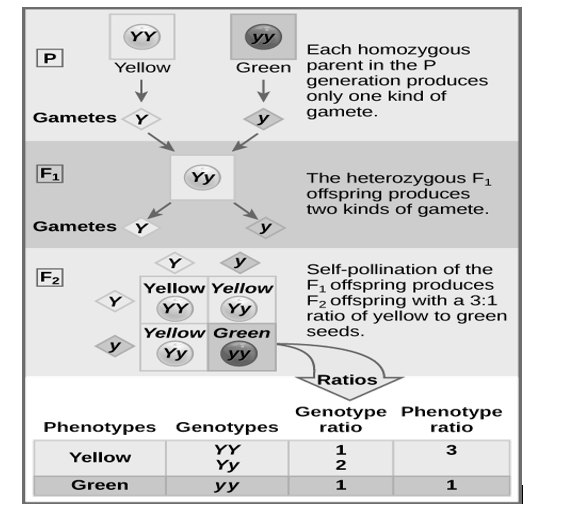
According to the Law of Independent Assortment, the alleles of two pairs of traits separate independently from each other during gamete formation, and get randomly rearranged in the offspring at the time of fertilization, producing both parental and new combinations of traits. A suitable example of the law of independent assortment. The observations indicate that when two pure-breeding pea plants are crossed: one with yellow, round seeds (YYRR) and one with green, wrinkled seeds (yyrr). as each parent is homozygous, according to law of segregation the gametes formed by the wrinkled, green plant all are ry, and the gametes formed by the round, yellow plant are all RY. That produces an offspring where are all RrYy.
The allele specifying yellow seed color is dominant to the allele specifying green seed colour, and the allele specifying round shape is dominant to the allele specifying wrinkled shape, as shown by the capital and lower-case letters. This observation culminates that plants are all yellow and round, because they are heterozygous for two genes, called dihybrids (di- = two, -hybrid = heterozygous).
A cross between two dihybrids (self-fertilization of a dihybrid) is known as a dihybrid cross. When Mendel did this cross between the dihybrids, he found that the resulting offspring, were found to be of four different categories of pea seeds: yellow and round, yellow and wrinkled, green and round, and green and wrinkled. These phenotypic categories (categories that are specified on observation of traits) appeared in a ratio of approximately 9:3:3:1 9:3:3:1
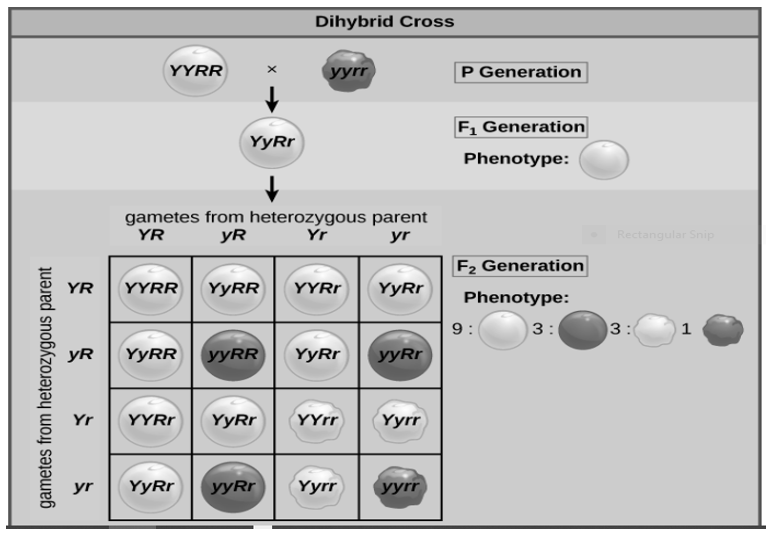
The resulting offspring, were found to be of four different categories of pea seeds: yellow and round, yellow and wrinkled, green and round, and green and wrinkled. These phenotypic categories (categories that are specified on observation of traits) appeared in a ratio of approximately 9:3:3:1 9:3:3:1
Q5) Define Mitosis and Meiosis?
A5) Mitosis is the process that occurs when somatic cell divides to form two daughter cells. It is an important process in normal organism development, Mitosis requires a set of specialized cell structures. Chromosomes are the most important part for mitosis because they are separated during the process and evenly distributed into two daughter cells. The spindle is formed around a cytosolic structure called centrosome, which is main driving force for chromosome separation.
Meiosis is the type of cell division by which germ cells (eggs and sperm) are produced. Meiosis involves a reduction in the amount of genetic material, during meiosis, chromosomes are also duplicated, cell division occurs twice consecutively, leading the half of the chromosome number in 4 daughter cells. This process is used for generating germ line cells, the gametes.
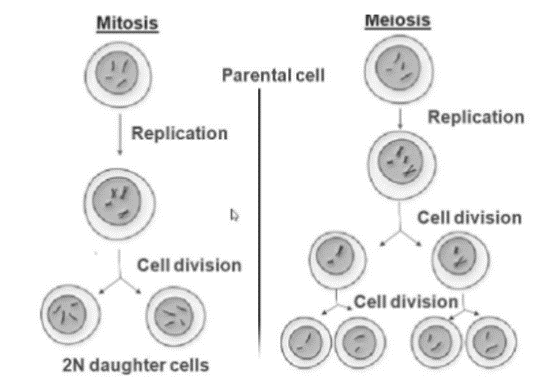
Fig: Mitosis is the process that occurs when somatic cell divides to form two daughter cells and During meiosis, chromosomes are also duplicated, cell division occurs twice consecutively, leading the half of the chromosome number in 4 daughter cells
Q6) What do you understand by Epistasis?
A6) Theinteraction that occurs between nonallelic genes at two or more loci resulting in one gene masking the phenotypic expression of another gene, Epistasis is defined as the interaction between genes that influences a phenotype. Genes can either mask each other so that one is considered “dominant” or they can combine to form a new trait. It is the conditional relationship between two genes that can determine a single phenotype of some traits. At each locus there are two alleles that decide phenotypes. They can affect one another in such a way that, regardless of the allele of one gene, it is recessive gene to one dominant allele of the other.
Q7) Explain the single Gene disorders in humans?
A7) When a certain gene is found to cause a disease, we refer to it as a single gene disorder or a Mendelian disorder. In fact, single gene disorders are not very common. For example, only one in 2,500 people are born with cystic fibrosis. There are a number of inheritance patterns of single gene disorders that are predictable it is figured out.
There are more than 4,000 human diseases caused by single mutated genes that can be passed on to subsequent generations in either a dominant or recessive manner. Both egg and sperm providers may unknowingly be carriers of a single gene disorder, which makes it crucial to screen both partners.
Some examples of single-gene disorders include
Q8) Elaborate the concept of Dominance and Recessiveness?
A8) Everyone inherits two copies of each gene from their parents, and the copies can either be different or the same. If the copies are different, then one is going to mask the effects of the other. The gene that trumps over the other is usually known as the dominant gene, and the weaker gene is known as recessive. In the presence of a dominant gene, a recessive gene will not manifest its traits. When two recessive genes are paired however, their traits will be manifested. Dominant genes are also the ones whose traits are manifested in the offspring. For recessive traits to be manifested, both parents have to carry that recessive gene singly or in a pair. Theprinciple determines the presence of similar and differences amongfamily members. There are traits which will definitely appear in the child, whenever present these are known as dominant traits, other traitswill be recessive only in the absence of a dominant traits
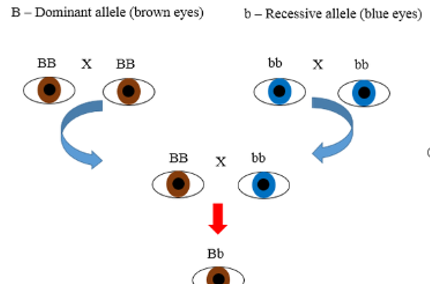
Q9) Define Genetics in general?
A9) Genetics is a branch of biology concerned with the study of genetic variation, genes, and heredity in organisms. Though heredity had been observed for millennia, a scientist and Gregor Mendeland Augustinian Friar working in the 19th century, were the first people to study genetics scientifically. Mendel studied the concept of "trait inheritance", patterns in the way traits (characteristicfeatures) are carried down from parents to offspring. He noticed during his research that organisms (pea plants) inherit traits by way of discrete "units of inheritance". This term, still prevalent today, is an ambiguous definition of what is referred to as a gene.
Trait inheritance and inheritance mechanisms Molecular of genes are still primary principles of genetics in the 21st century, but modern genetics has expanded beyond inheritance to studying the function and behaviour of genes. The Gene structure and function, distribution and variation are studied within the context of the cell, the organism (e.g., dominance), and within the context of a population. Genetics has given rise to a number of subfields, including Molecular Genetics epigenetics and population genetics.
Q10) Explain the concept of matching Phenotype to genes?
A10) The genotype–phenotype distinction is drawn in genetics. "Genotype” is an organism's full information about heredity. "Phenotype" is an organism's properties that are actually observed, such as development, morphology or behaviour. This distinction is fundamental in the study of inheritance of traits and their evolution.
The chances of survival and reproductive output are determined by the organism physical properties, but the inheritance of physical properties is dependent on the inheritance of genes. Therefore, understanding the theory of evolution through natural selection, requires a deep understanding of the genotype–phenotype distinction. The genes contribute to a trait, and the phenotype is the observable expression of the genes (and therefore the genotype that affects the trait). For e.g. If a white mouse had recessive genes that caused the genes responsible for colour to be inactive, its genotype would be responsible for its phenotype (the white colour).
The mapping of a set of genotypes to a set of phenotypes is sometimes referred to as the genotype–phenotype an organism's genotype has a great influence (the largest by far for morphology) in the formation of its phenotype, but this is not the only case. Even two organisms with identical genotypes show differences in their phenotypes. One of the experiences in everyday life with identical twins (monozygous). Identical twins share the same genotype, since their genomes are identical; but they show the same phenotype, although their phenotypes may look similar. This is apparent that their mothers and close friends can spot minute differences, even though others might not be able to see the subtle differences. Further, identical twins can be distinguished by their fingerprints, which are never completely identical.